History of Salsa Music & Dance
Dance like no one is watching!
Following information was compiled from various sources on the Internet
Following categories are covered below:
1. Salsa Music and Dance Around the World (New York, Los Angeles, Cuba, Colombia, West Africa)
2. The History of Salsa and Timba
3. Cuban Casino style Salsa dancing
4. History of Salsa Rueda and what is Salsa Rueda
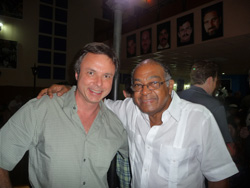 |
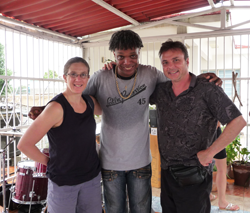 |
|
| Chris with Pupy, one of the original founders of Los VanVan (Cuba) |
Jessica and Chris with Giraldo Piloto in Havana, Cuba |
|
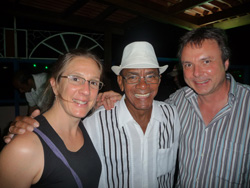 |
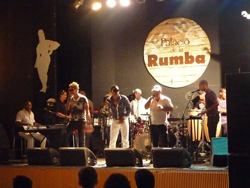 |
|
| Jessica & Chris with Eugenio “Raspa” Rodriguez of Septeto Nacional in Habana |
Palacio de la Rumba in Habana | |
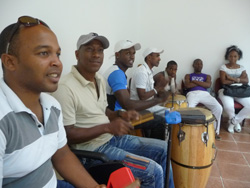 |
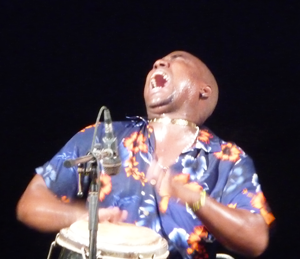 |
|
| Drummers at Rumba class | Drummer at the Palacio de la Rumba in Habana |
1. Salsa Music and Dance Around the World
New York (USA)
Salsa Music
During the 1940s and 50s, Cuban musicians had a huge influence on the New York music scene.But once Fidel came to power, diplomatic relations fell apart between Cuba and the US. Cuban musicians could no longer travel to the United States and Cuban recordings received no air play time. So the Puerto Rican and NuYorican (New Yorkers of Puerto Rican descent) musicians took on The Big Apple single handed.
These days New York salsa has a distinctly Puerto Rican sound ‚ smooth, polished, classic salsa. It tends to follow the jazz structure, incorporating lengthy instrumental breaks to showcase the ability of particular musicians.
Leading musicians playing NewYorican Salsa:
Celia Cruz
Willie Colon
Eddie Palmeiri
The Spanish Harlem Orchestra
Jimmy Bosch
Salsa Dance
The high concentration of Puerto Ricans and NuYoricans in New York, means that the New York salsa dance style is strongly Puerto Rican influenced, with an emphasis on fast flash footwork.
But, there‚is also a strong Latin Hustle influence in New York salsa dancing. It looks like this is a byproduct of the disco craze, which was HUGE in The Big Apple in the late 70‚s and early 80‚s. Take another look at Saturday Night Fever when you get the chance.Tony Manero (John Travolta) is King of the Latin Hustle in the local Brooklyn discos.
When salsa started to move into the Manhatten based clubs in the late 80‚s, many ex-Hustle dancers brought their disco moves into their salsa.
The current New York salsa style is called Mambo or Salsa On 2. It‚s a blend of Puerto Rican salsa and Latin Hustle with the break on the second beat of the clave. New Yorkers are quite fanatical about Salsa On 2 – there‚s stacks of internet sites which debate the finer points of ‚Salsa On 1″ and ‚Salsa On 2″.Explore them if you dare.
Los Angeles (USA)
Salsa Music
LA doesn’t have a distinctive salsa music style. Local bands adopt the Puerto Rican classics. In LA-style Salsa Cuban salsa music isn’t popular, as it doesn’t work with the LA dance style.
Salsa Dance
LA style salsa moves are designed to dazzle the spectator – exciting, sexy and flamboyant with lots of dips, spins and drops.
The dominant influences are from Puerto Rican salsa, Latin Ballroom and probably Lindy Hop (an American dance that evolved in Harlem, New York City, in the 1920s and 1930s and originally evolved with the jazz music of that time.)
The LA style “shines” have their roots in Latin Ballroom. Couples break away from each other in the middle of a dance to start “shining”. Women will extend their arms to strike a pose, then play with stylised hip and hair movements.
Men’s shines tend to focus on tricky footwork based on Puerto Rican style salsa.
LA style salsa dancers often develop highly choreographed cartwheel and flip routines into their movements.
Cuba
Salsa Music
The contemporary salsa sound coming out of Cuba is called‚ timba. It’s a fast tempo salsa with a strong afro-cuban influence. Songs will often follow a traditional rumba structure – start slow, break into a core salsa rhythm, then settle into a beautiful call and response vocal pattern. The backing vocalists keep the standard response running while the lead vocalist improvises. Ahi Na Ma!
The other feature of cuban timba is that it often blends other rhythms into the breaks. Reggae, rap and hip hop have a huge following in Cuba, and the timba musicians love to play with those rhythms, and intertwine them into their salsa.
Cuban dancers have a lot of fun at these times – they pull back from a close embrace and launch into rhythmic middle body shudders and amazing buttock trembles ‚ all movements derived from afro-cuban rumba.
Some musicians in Cuba known for Timba (but also for Son):
Los Van Van
Pupy Y Los Que Son Son
Habana de Primera
Alexander Abreu
Maraca
Charanga Habanera
NG La Banda
Bamboleo
Manolito Simonet
El Nino y la Verdad
See more about Timba in “History of Salsa and Timba”
Salsa Dance
Cubans call their salsa dance style ‘casino’.
In the decadent days of Old Havana, all the action in town was going down at the Casinos. The gambling haunts had the money to bring in the big name bands, so that’s where people would go to dance.
Come the revolution, the casinos were closed, and the people started to dance ‘casino’ style in the local community halls. The name stuck, so don’t be confused when a Cuban invites you to go out dancing ‘casino’ you’re off to the salsa club!!
Cuban style salsa differs from the north american salsa styles in that it is ‘circular’ rather than linear. The man constantly moves around the woman in a circular dynamic, checking her out and showing her off. Exhibala!
Salsa Rueda de Casino (“Salsa Rueda”) Dance
Rueda de Casino is the correct name in Spanish. “Casino Rueda” or “Salsa Rueda” are English versions of the correct name, due to the fact that the grammatical structure of English is a bit backwards from Spanish!
Rueda is a synchronised cuban group dance with constantly exchanging dance partners.
It started out in the 1950’s at the Casino Deportivo in Havana. The people invented a new casino dance, using popular dance steps of the time, danced as a group in a circle or wheel.
In Cuba, the people used to get together in large halls, called ‘Casinos’ hence the name. Some say it started in Santiago de Cuba, others say it started in the famed Casino Deportivo in Havana, or the Casino de la Playa, I don’‚t know for sure, I wasn’t there! When the casinos were closed, people still referred to the dance style by using the name of the places where people used to gather to do it: “casino” and the name stuck. Nowadays people refer to the music as “salsa” and the dance as “casino”.
Casino itself has its roots in the ‘Danz’n, as well as its derivative, the Son Afro-Cuban dances such as Guaguane the Mambo, a rhythm invented by Cachao in the world-famous Tropicana Club in Havana, in 1943, and popularized by Perez Prado in Mexico, and “Cha-cha-cha” invented by Enrique Jorre.
Rueda (as it is commonly called in Cuba) is a form of Casino danced in a round with 2 or more couples exchanging partners when one person calls out the turn names (“Rueda” is Spanish for ‘Wheel’ and ‘Casino’ is known outside of Cuba as ‘Salsa’).
In the old casinos, the rueda circle would only be limited by available space – sometimes as many as 100 couples would dance in the rueda circle !!
Modern rueda uses the same kinds of turns and steps you would normally use in ordinary salsa dancing. Each move has a name, which is called by the leader of the Rueda. Leaders execute the move and pass the follower around to the next leader in the circle. Calls come in quick succession, creating an exciting dynamic between the dancers.
The steps that are considered the ‘core’ steps are danced in a similar fashion around the world and are the basic ones. Some of them are: Al Medio, Abajo, Dile que No, Adios, Adios con Hermana, (called “La Prima” in Cuba and Europe) Echufe (or in Miami: Enchufla), etc. The names may vary somewhat, but those are pretty basic steps, and which are danced in Cuba, as well as in Santiago, Chile; Denver, Colorado and even Positano, Italy!
What happens next is a result of dance in general being a fluid and ever-changing entity, not stagnant. Moves are invented locally that reflect cultural reality. In Chile you might find a step named ‘Entel Chile’, with a move that mocks someone talking on the phone, since Entel is the largest phone company in Chile. In Miami we have a step called ‘Balsero’, which imitates the movements of the waves (‘Balsero’ is someone who comes to the YUMA (USA) by ‘balsa’ or ‘raft’). You won’t find that move in Chile because nobody gets to Chile by raft!
While some of the moves are graceful and intricate, others are just plain funny, such as ‘fly’ where the guys slap their palms together over the girls’ heads in a pretend fly-catcher move (as in “fly ball”, not the kind that buzzes around your food!). After all, what is dancing all about if not to have fun with it?!
Colombia
Salsa Music
The hot salsa sound to come out of Colombia is Salsa Dura – Hard Salsa.
Colombian salsa is beautiful salsa for dancing and very popular among Wellington salsa dancers. It’s got a fast rhythm and a wicked big brass sound, reminiscent of the glory days of cuban mambo.
Leading musicians playing Colombian Salsa:
Fruko Y Sus Tesos
Joe Arroyo Y La Verdad
Sonora Carruseles
Latin Brothers
Group Niche
Salsa Dance
If you’ve ever seen Colombians dance salsa, it’s amazing – incredibly fast footwork and tight spins. Colombians dance salsa really really close,the bodies of the two dancers glued together – almost completely touching each other, from head to toe.
So why do they dance so close?
1. Coz the dance floors are so crowded, there’s no space for large spins.
2. The music’s so fast that the footwork’s gotta be fast and small.
3. Coz that’s how Colombian’s like their salsa
West Africa
Salsa Music
We’e included a section on West African salsa coz it’s so popular among Wellington salsa dancers. Whenever the DJ puts on an Africando track, the dance floor rocks!!
In the 1940s and 50s, afro-cuban rhythms were all the rage from the Ivory Coast to Benin, Senegal to The Congo. Senegalese soldiers fighting for France in World War II brought home recordings of the latest cuban bands playing in Paris.
The West Africans recognized something familiar in the music. The majority of the slaves transported to Cuba came from West Africa. These infectious new dance beats had their roots in the rhythms the slaves took to the New World.
Contemporary West African salsa is wild – spacey electric guitar solos, swooping saxophone lines and wicked percussion. The musicians tend to use traditional west african percussion instruments in their salsa band line up, so you’ll often hear the tama (talking drum) vibrating it’s way through the tracks.
Vocals may be in spanish, but are more likely to be on local tribal languages such as Wolof or Mandinga.
Leading musicians playing West African Salsa:
Africando
Orchestra Baobab
Pape Fall
Ricardo Lemvo
Manu Dibango + Cuarteto Patria
Salsa Dance
Salsa West African style is called salsa mbalax. It’s more african based than latin.
If you made it to Womad Taranaki 2003, then you would have been treated to a salsa mbalax dance spectacular, care of Cheik Lo’s band from Senegal.
The band were playing a Wolof version of the cuban classic El Carretero. The tama player launched into a high energy afrobeat dance at one point, lifting his knees into the air. Then he hitched up his long flowing robe, crouched, gave the crowd a big smile, and rotated his hips provocatively down, down, down.
Vocals are based on call and response chant. The lead vocalist will often improvise and tell stories Рwhat happened at the fish market last week, who the most gorgeous girl in the barrio is dating, and what’s gonna happen when he leaves for Miami next week.
back to top
2. The History of Salsa and Timba
Salsa
Salsa is one of the most dynamic and important musical phenomena of the 1900’s. In many Hispanic communities, it remains today the most popular style of dance music. Salsa represents a mix of Latin musical genres, but its primary component is Cuban dance music. The roots of salsa originated in Eastern Cuba (Santiago de Cuba, Guantanamo) from the Cuban Son (about 1920) and Afro-Cuban dance (like Afro-Cuban rumba). There, Spanish and Afro-Cuban musical elements were combined, both in terms of rhythm and the instruments used. By mid-century, this music came to Havana where foreign influences were absorbed, particularly American jazz and popular music heard on the radio.
By the end of the l950s, many Cuban and Puerto Rican people including musicians had settled in the U.S., especially in New York. This created the environment where salsa music completed its development. “El Barrio” (Spanish Harlem) was the main place where this occurred. Many bands were formed; immigrants continued to make Afro-Caribbean music, but they adapted the sound to their new world. They were influenced especially by American jazz. Gradually in the 50s and 60s, salsa as we know it today was emerging. The most famous musicians of that time were Tito Puente, called the King of Mambo, and Celia Cruz, known as the Queen of Salsa.
The rise of salsa music is also tied closely to Fania Records which was founded in 1964 by the musician Johnny Pacheco and an Italian-American divorce lawyer named Jerry Masucci. The two met at a party in a NY hotel. They struck a deal to launch what became the most influential record label in Latin music’s history. Fania was known as “the Latin Motown,” with one huge hit after another becoming popular all over Latin America. Many artists became very famous with the promotion they received from the record label “La Fania.” Fania Records remolded Cuban music into a sound more appropriate to Latin New York, and they called the sound “salsa.” By he l970s salsa was becoming so popular that Fania’s bands and artists were touring all over Latin America. This decade was the real “heyday” of salsa.
The type of salsa music that Fania promoted came to be referred to as “hard salsa.” Then in the 80s, another style of salsa which was softer and more romantic was born, with artists like Gilberto Santa Rosa. Around this time, Latin musicians began to have an impact on mainstream U.S. music. Latin music was becoming trendy here and beginning to intrigue the rest of the world as well.
Both types of salsa remain popular today and with the popularity of the music, came the popularity of the dance.
Every Salsa composition involves complex African percussion based around the Clave Rhythm (which has four types), though there can be moments when the clave is hidden for a while, often when quoting Charanga, Changüí and Bomba.
The key instrument that provides the core groove of a salsa song is the clave. It is often played with two wooden sticks (called clave) that are hit together. For salsa, there are four types of clave rhythms, the 3-2 and 2-3 Son claves being the most important, and the 3-2 and 2-3 Rumba claves. Most salsa music is played with one of the Son claves, though a Rumba clave is occasionally used, especially during Rumba sections of some songs.
There are other aspects outside of the Clave that help define Salsa rhythm: the cowbell, the Montuno rhythm and the Tumbao rhythm.
The cowbell is played on the core beats of Salsa, 1, 3, 5 and 7. The basic Salsa rhythm is quick, quick, slow, quick, quick, slow, in other words, 1, 2, 3, 5, 6 and 7, which are very similar to the beats of the cowbell. Recognizing the rhythm of the cowbell helps one stay on Salsa rhythm.
The Montuno rhythm is a rhythm that is often played with a piano. The Montuno rhythm loops over the 8 counts and is useful for finding the direction of the music. By listening to the same rhythm, that loops back to the beginning after eight counts, one can recognize which count is the first beat of the music.
Tumbao is a rhythm in salsa that is played with the conga drums. It sounds like: “cu, cum.. pa… cu, cum… pa”. Its most basic pattern is played on the beats 2,3,4,6,7, and 8. Tumbao rhythm is helpful for learning to dance contra-tiempo (“On2”).
Timba
Timba is a Cuban genre of music, sometimes referred as salsa cubana (‘Cuban salsa music’). However, the historical development of timba has been quite independent of the development of salsa in the United States and Puerto Rico and the music has its own trademark aspects due to the Cuban Embargo and strong Afro-Cuban heritage.
The word timba is part of a large family of ìmbî and ìngî words which made their way into Spanish from African languages. Among the hundreds of other examples are tumba, rumba, marÌmba, kalimba, mambo, conga, charanga, and bongo, with more being invented every year. At least as far back as 1943, the word timba was used in lyrics and song titles such as Casino de la Playa’s Timba timbero and Perez Prado’s Timba timba. It’s also the name of a neighborhood in Havana.
It came into use as a music genre name, first as timba brava, around 1989. Many, most famously NG La Banda’s leader Jose Luis “El Tosco” Cortes, claim credit for being the first to use it to describe the new musical phenomenon
The main precursors of timba are three bands: Los Van Van, Irakere (both in the 1970s) and NG La Banda (1980s), though many other bands (e.g. Son 14, Orquesta Original de Manzanillo, Ritmo Oriental, Orquesta Revé) were influential in setting new standards.
3. Cuban Casino style Salsa dancing
Historically, Casino traces its origin as a partner dance from Cuban Son dancing, and its rhythmic body motions from Afro-Cuban Rumba heritage. Son is considered an older version and ancestor to Salsa. Son is danced on delay measure upbeat (contra-tiempo) following the 2-3 clave (Son Clave) whereas Casino is usually danced on the downbeat break of 1 or 3 (a-tiempo).
Casino was popularized in the late 1950s as the Cuban Son received upbeat and quicker arrangements by musicians. Casino has a very independent development, free from external influences such as Puerto Rican and North American dances partly due to the effect of the Cuban Embargo.
Cuban-style salsa, also known as Casino, is popular in many places around the world, including in Europe, Latin America, North America, and even in some countries in the Middle East. Dancing Casino is an expression of popular social culture; Latin Americans consider casino as part of social and cultural activities centering around their popular music. The origins of the name Casino are derived from the Spanish term for the dance halls where a lot of social Salsa dancing was done in Cuba during the mid-20th century and onward.
4. History of ‘Salsa Rueda’ and what is ‘Salsa Rueda’
History of ‘Salsa Rueda’
In order to speak of the antecedents of the Rueda de Casino it is necessary to go back to the reign of Luis XIV in France where the first ballets appeared. As of that moment they instituted “ballets de corte”. In order to have a good title it was necessary to know certain choreographies that were performed in the celebrations of the nobility. Clear examples: the Minuet and the Contradanzas.
In the XVIII century, with the presence of French fleets in the bay of Havana, the arrival of emigrants of Louisiana, New Orleans and fundamentally the French emigration coming from Haiti with the 1791 revolution produced the appearance in Cuba of the French Contradanzas and derived from this the Cuban Contradanza arises. The court of Luis XIV, the Creole aristocracy, Spanish and including the town interpreted the dance with pre-planned figures that all had to know and directed by a bastonero.
There have been contradiction between the informants of the place where casino fist appeared. Some say that it first appeared in the Spanish Casino, Grammar school of Havana, the Patricio Lumumba and others say in the Sport Casino; what is true is that it expanded throughout the capital.
Rueda de Casino takes its name from the club, ‘El Casino Deportivo’, where it originated. In the 1950s many great dancers gathered there for friendly competitions. They would practice all week to invent new moves and go to the club to show them off. Sooner or later they began to dance the moves together. In order to keep a distinction between one move and another, they began naming them and Rueda de Casino was born.
As a result of the Castro regime, many Cubans immigrated to the US, a large portion of which to the Miami area. With them they took their culture including various foods, music and dancing. Rueda de Casino began to slowly make its way into the Miami salsa community and in the late 1980s and early 1990s it experienced an enormous explosion of popularity. There it has been so embraced, that one is hard-pressed to find a nightclub in which Casino or Rueda is not danced.
Rueda de Casino became a national phenomenon after Rosendo, choreographer and dancer of the “Ballet de la Televisi∆ín Cubana”, presented it in the televising program Para Bailar in 1980.
This festive dance, which was brought to Miami by Cuban immigrants, took hold there in the l970s and l980s. From Miami, it spread first to major U.S. metropolitan centers with large Hispanic populations and eventually to other cities as well. The movie “Dance with Me” has a segment of rueda dancing which helped poplularize the dance in this country.
Salsa Casino has evolved in Miami to such an extent that a new and distinctly different style has emerged. Miami style.
What is ‘Salsa Rueda’?
“Rueda” means wheel or circle. It is a type of salsa dancing done by a group in a circle, with partners being passed around.
This wildly popular dance was done everywhere in Cuba—in the streets, in parking lots, in clubs, in homes.
The moves to this dance are numerous and can be very complex. The dance is done by two or more couples who do the moves in synchrony. A member of the circle calls the moves for everyone to execute.
Each move has a name and most have hand signals since it is hard to hear in noisy nightclubs. Moves can be called in quick succession, and along with frequent partner exchanges, this creates a very dynamic and exciting atmosphere for everyone involved.
The group nature of the dance is unique and makes it quite social. A group consciousness develops to make the rueda work well—with everyone watching the leader for the calls. Dancers have to open up their sphere of awareness far beyond what is necessary for ordinary partner dancing.
Whether you are dancing or watching, it is thrilling when a rueda circle works well and flows smoothly!! Rueda can be done to any salsa music. It is best danced to music with a driving beat and no rhythm breaks. (Latin music often changes rhythm throughout one song, unlike American music.)
The timing of the dance is “quick, quick, slow”—-exactly the same as salsa. The “slow” beat is twice as long as the “quicks.” Hence there are 4 beats to a measure and the dancer steps on 3 of them. Note that salsa dancers can step on beats 1, 2 and 3 or on beats 2, 3, and 4.
The former pattern is called “dancing on 1” and the latter is called “dancing on 2,” assuming that the first step is the rock step. Most Cubans dance on two, and some American dancers prefer the more relaxed feeling that dancing on two creates. However, some dancers prefer to dance on one since that is more consistent with an American approach to music, and the first beat is easier to find. Dancing on two is a little more musically difficult. Rueda in this country is generally danced on one. To the reader, this difference–which beat the dance pattern starts on—may seem like a small matter. But to serious “on 1” or “on 2” dancers, it is the stuff of endless discussion and debate!